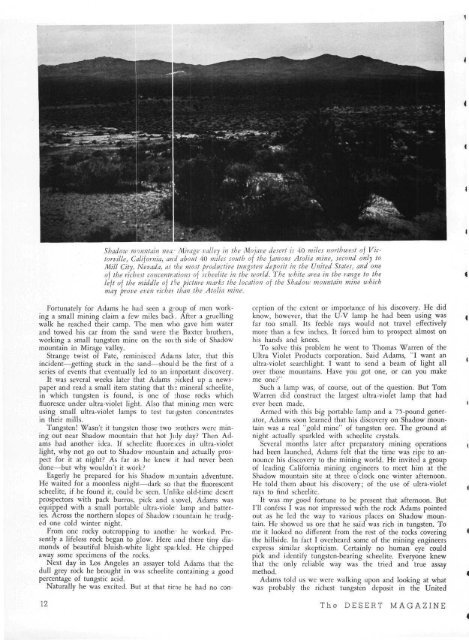the magazine y - Desert Magazine of the Southwest
the magazine y - Desert Magazine of the Southwest
the magazine y - Desert Magazine of the Southwest
Create successful ePaper yourself
Turn your PDF publications into a flip-book with our unique Google optimized e-Paper software.
*•> r'f<br />
Shadow mountain near Mirage valley in <strong>the</strong> Mo jape desert is 40 miles northwest <strong>of</strong> Victorville,<br />
California, and about 40 miles south <strong>of</strong> <strong>the</strong> famous Atolia mine, second only to<br />
Mill City, Nevada, as <strong>the</strong> most productive tungsten deposit in <strong>the</strong> United States, and one<br />
<strong>of</strong> <strong>the</strong> richest concentrations <strong>of</strong> scheelite in <strong>the</strong> world. The white area in <strong>the</strong> range to <strong>the</strong><br />
left <strong>of</strong> <strong>the</strong> middle <strong>of</strong> <strong>the</strong> picture marks <strong>the</strong> location <strong>of</strong> <strong>the</strong> Shadow mountain mine which<br />
may prove even richer than <strong>the</strong> Atolia mine.<br />
Fortunately for Adams he had seen a group <strong>of</strong> men working<br />
a small mining claim a few miles bad. After a gruelling<br />
walk he reached <strong>the</strong>ir camp. The men who gave him water<br />
and towed his car from <strong>the</strong> sand were <strong>the</strong> Baxter bro<strong>the</strong>rs,<br />
working a small tungsten mine on <strong>the</strong> sotth side <strong>of</strong> Shadow<br />
mountain in Mirage valley.<br />
Strange twist <strong>of</strong> Fate, reminisced Adams later, that this<br />
incident—getting stuck in <strong>the</strong> sand—should be <strong>the</strong> first <strong>of</strong> a<br />
series <strong>of</strong> events that eventually led to an important discovery.<br />
It was several weeks later that Adams picked up a newspaper<br />
and read a small item stating that th; mineral scheelite,<br />
in which tungsten is found, is one <strong>of</strong> "hose rocks which<br />
fluoresce under ultra-violet light. Also that mining men were<br />
using small ultra-violet lamps to test tungsten concentrates<br />
in <strong>the</strong>ir mills.<br />
Tungsten! Wasn't it tungsten those two mo<strong>the</strong>rs were mining<br />
out near Shadow mountain that hot July day? Then Adams<br />
had ano<strong>the</strong>r idea. If scheelite fluoresces in ultra-violet<br />
light, why not go out to Shadow mountain and actually prospect<br />
for it at night? As far as he knew it had never been<br />
done—but why wouldn't it work?<br />
Eagerly he prepared for his Shadow mauntain adventure.<br />
He waited for a moonless night—dark so I hat <strong>the</strong> fluorescent<br />
scheelite, if he found it, could be seen. Unlike old-time desert<br />
prospectors with pack burros, pick and shovel, Adams was<br />
equipped with a small portable ultra-viole: lamp and batteries.<br />
Across <strong>the</strong> nor<strong>the</strong>rn slopes <strong>of</strong> Shadow mountain he trudged<br />
one cold winter night.<br />
From one rocky outcropping to ano<strong>the</strong>r he worked. Presently<br />
a lifeless rock began to glow. Here ;ind <strong>the</strong>re tiny diamonds<br />
<strong>of</strong> beautiful bluish-white light sparkled. He chipped<br />
away some specimens <strong>of</strong> <strong>the</strong> rocks.<br />
Next day in Los Angeles an assayer told Adams that <strong>the</strong><br />
dull grey rock he brought in was scheelite containing a good<br />
percentage <strong>of</strong> tungstic acid.<br />
Naturally he was excited. But at that time he had no con-<br />
ception <strong>of</strong> <strong>the</strong> extent or importance <strong>of</strong> his discovery. He did<br />
know, however, that <strong>the</strong> U-V lamp he had been using was<br />
far too small. Its feeble rays would not travel effectively<br />
more than a few inches. It forced him to prospect almost on<br />
his hands and knees.<br />
To solve this problem he went to Thomas Warren <strong>of</strong> <strong>the</strong><br />
Ultra Violet Products corporation. Said Adams, "I want an<br />
ultra-violet searchlight. I want to send a beam <strong>of</strong> light all<br />
over those mountains. Have you got one, or can you make<br />
me one?"<br />
Such a lamp was, <strong>of</strong> course, out <strong>of</strong> <strong>the</strong> question. But Tom<br />
Warren did construct <strong>the</strong> largest ultra-violet lamp that had<br />
ever been made.<br />
Armed with this big portable lamp and a 75-pound generator,<br />
Adams soon learned that his discovery on Shadow mountain<br />
was a real "gold mine" <strong>of</strong> tungsten ore. The ground at<br />
night actually sparkled with scheelite crystals.<br />
Several months later after preparatory mining operations<br />
had been launched, Adams felt that <strong>the</strong> time was ripe to announce<br />
his discovery to <strong>the</strong> mining world. He invited a group<br />
<strong>of</strong> leading California mining engineers to meet him at <strong>the</strong><br />
Shadow mountain site at three o'clock one winter afternoon.<br />
He told <strong>the</strong>m about his discovery; <strong>of</strong> <strong>the</strong> use <strong>of</strong> ultra-violet<br />
rays to find scheelite.<br />
It was my good fortune to be present that afternoon. But<br />
I'll confess I was not impressed with <strong>the</strong> rock Adams pointed<br />
out as he led <strong>the</strong> way to various places on Shadow mountain.<br />
He showed us ore that he said was rich in tungsten. To<br />
me it looked no different from <strong>the</strong> rest <strong>of</strong> <strong>the</strong> rocks covering<br />
<strong>the</strong> hillside. In fact I overheard some <strong>of</strong> <strong>the</strong> mining engineers<br />
express similar skepticism. Certainly no human eye could<br />
pick and identify tungsten-bearing scheelite. Everyone knew<br />
that <strong>the</strong> only reliable way was <strong>the</strong> tried and true assay<br />
method.<br />
Adams told us we were walking upon and looking at what<br />
was probably <strong>the</strong> richest tungsten deposit in <strong>the</strong> United<br />
12 The DESERT MAGAZINE

















